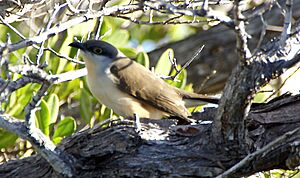Dark-billed cuckoo facts for kids
Quick facts for kids Dark-billed cuckoo |
|
|---|---|
 |
|
| Conservation status | |
| Scientific classification | |
| Genus: |
Coccyzus
|
| Species: |
melacoryphus
|
 |
|
The dark-billed cuckoo (Coccyzus melacoryphus) is a type of bird that belongs to the cuckoo family. You can usually find it in most countries in mainland South America, except for Chile. It also lives on the Galápagos Islands. Sometimes, it flies to other places like Chile, Panama, or even Florida and Texas by accident.
Contents
What Does It Look Like?
The dark-billed cuckoo is about 25 to 28 centimeters (10 to 11 inches) long. About half of its length is its tail! Males weigh around 42 to 54 grams (1.5 to 1.9 ounces), and females are a bit heavier, weighing 50 to 66 grams (1.8 to 2.3 ounces).
Both male and female cuckoos look the same. They have a gray head and neck, with grayish-brown feathers on their back. Their wings are a darker grayish-brown. Their tail feathers are brown on top. The feathers underneath are black with white tips, which helps them stand out.
Their face is gray with a wide black "mask" that goes past their eye. Around their eye, there's a thin ring of bare skin that can be yellow or gray. Their belly is a pale, light brown color, and their chest is a bit darker. Young cuckoos look similar to the adults but are not as brightly colored. Their head and neck are brown, and their tail feathers have gray tips.
Where Does It Live?
You can find the dark-billed cuckoo regularly across most of South America. It lives in many different kinds of places. These include tropical forests, especially along rivers (called gallery forests), and younger forests that are growing back. They also like to live in mangrove swamps, which are coastal areas with special trees that grow in salty water.
These birds usually live in low-lying areas, below 950 meters (3,100 feet). However, they have been seen as high as 3,600 meters (11,800 feet) in some places!
How Does It Behave?
Moving Around
Some dark-billed cuckoos stay in the same place all year. For example, those on the Galápagos Islands and in parts of Colombia, Ecuador, and Peru don't move much.
However, many cuckoos are travelers! Birds living in southern Brazil, Uruguay, and Argentina fly north for the winter months (March to October). Cuckoos that breed in Venezuela also move south after they finish nesting. You can find this species in most of the Amazon basin only during the southern winter.
What Does It Eat?
The dark-billed cuckoo's diet is almost entirely made up of insects. They eat both adult insects and their larvae (young forms, like caterpillars).
Making a Home and Raising Chicks
The dark-billed cuckoo builds a simple, flat nest. It's made of sticks and placed in a tree or a bush. In most areas, they lay two or three greenish-blue eggs. But in Argentina, they often lay three or four eggs, and sometimes even five!
The mother cuckoo starts sitting on the eggs as soon as the first one is laid. This means the chicks hatch at different times, so they can be different sizes in the nest.
What Does It Sound Like?
The dark-billed cuckoo has a unique song. Some people describe it as "six to eight buzzy notes" that sound like a kazoo. Others say it sounds like a "ventriloquial ga-ga-ga-go-go." They also make a "descending series of guttural notes" and a dry, buzzing call that sounds like dddddrr.
Is It Safe?
The IUCN (International Union for Conservation of Nature) has looked at the dark-billed cuckoo. They have decided it is a species of Least Concern. This means that it is not currently in danger of disappearing.
The bird lives across a very large area. Even though we don't know exactly how many there are, scientists believe their numbers are stable. There are no immediate threats that would put this bird in danger. It is considered quite common throughout the places where it lives.
Images for kids



